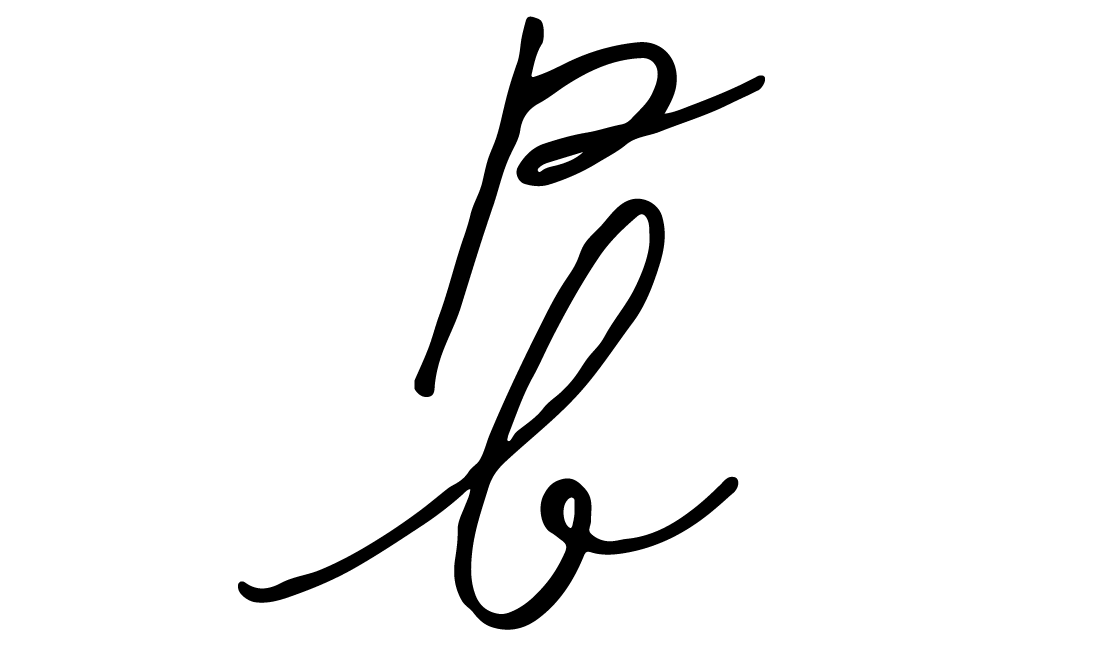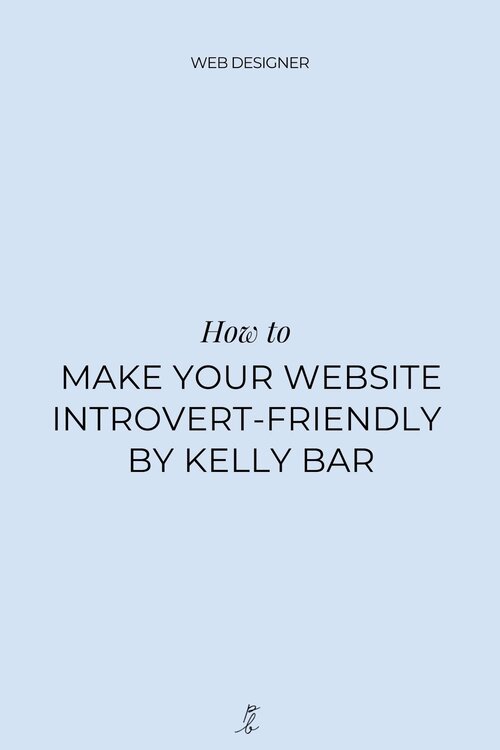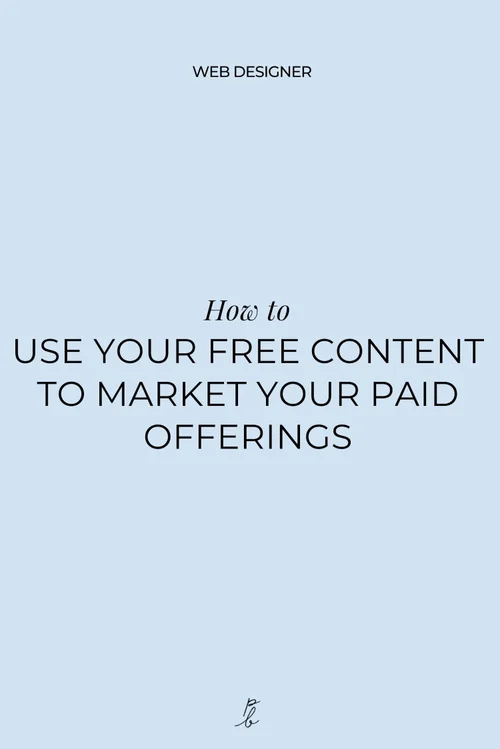How to make your website introvert-friendly by Kelly Barr
Just stumbling upon our featured student series?
My team and I have been super busy BTS rounding up insider tips and success stories from past Square Secrets™️ & Square Secrets Business™️ students to hopefully encourage and inspire you on your own journey to building a web design business you love!
And this next guest is sure to do just that!
Kelly Barr, past student and talented designer behind kellytheintrovert.com, is sharing how she makes sure that every site she designs is set up to convert not just the outgoing and the extroverted, but also another type of dream client…
One with equally dreamy projects and equally dreamy budgets, but that you may accidentally be overlooking as a web designer…
Who is this dream client? The Introvert!
Before Kelly dives into the ‘why’ and ‘how’ of designing introvert-friendly sites for yourself and your client, can we just appreciate the absolute gorgeousness that is her own website?👇
I MEAN 🤩🤩🤩….
How to design websites that are introvert-friendly
Attract more dream clients from the quieter side of the room — by Kelly Barr
Depending on who you ask (or which study you follow), introverts make up somewhere between 25-40% of the population. Either way, we’re sitting squarely outside the majority.
Personally? I like to think we’re just really good at hiding and being mysterious.
Unfortunately, sometimes we’re so good at hiding that no one knows how to find us.
So, I’d like to change that. The best part is, most (if not all) of these suggestions might just be welcomed by the more outgoing members of your audience, too.
By the way, hi, hello 👋 I’m Kelly and (surprise!) I’m an introvert. An INFP to be exact. #awkwardhighfive
Let’s get to it.
This is my processing face.
One of the first things to remember when communicating with introverts is our need to process information internally first, before making most decisions. In fact, this is one of the defining characteristics that makes an introvert an introvert — not the fact that we’re (usually) a little quieter. Or you know, quirkier. #isaidit
In other words, shyness does not an introvert make.
In the MBTI® personality framework, you’re an introvert if your dominant cognitive function is introverted.
As an INFP, that big ol’ F equals Introverted Feeling (my dominant cognitive function 🤓 ), and that means I’m going to rely on my own internal system of values (#feelings) first to decide what I’m going to do next. Push me too hard to make a decision on the spot? Watch as everything goes haywire in a glorious mental meltdown.
An INTJ, on the other hand, will probably (okay, definitely) be more decisive than I am. But only after they’ve run the information through their internal filter, Introverted Intuition, first.
Introverts process by reflecting within themselves first. Extroverts process by interacting with the outside world first.
So, what the heck does this have to do with web design?
If you want to attract more introverted clients...give us information.
Lots of it.
And then let us think about it on our own, before talking to you about our decision.
Show me the prices.
Let's say I'm a photographer looking for a web designer. I tried DIY-ing my own Squarespace site, but now I’m ready to call in the reinforcements. I want the best and I’m willing to pay for it.
After combing through the Google search results, I find you, my dream designer. Your portfolio is amazing, your reviews are amazing, and now I’m picturing my own amazing website coming to life.
At one point, I even say out loud (while alone in my kitchen, of course), “Wow, that was done on Squarespace?!”
Excitement level: 🤩🤩🤩🤩🤩
I quickly scan the navigation bar, looking for anything that says Pricing or Investment. This is it!
Aaaand, then... after scrolling through all your testimonials and beautiful photos and “what would it be worth to you?” value statements, I finally get to the bottom of the page:
“We customize our packages to fit your needs, email for details!”
::womp womp::
Excitement level: 😐😐😐
NOPE.
I’m not emailing you.

At this point, you may be thinking, ‘what's the big deal, introverts like email?’
So let's rewind, and say I do “email you for details.”
The problem is...
I’m already irritated on an existential level that the Pricing page had no actual pricing.
Not only can I not check this off my to-do list because I'm waiting on your reply (sometime in the next 48-317 business hours but also probably longer because it's a Saturday), but I'm not even looking forward to it anymore, because it’s going to require an extra conversation. Or seven.
You've now created an open loop in my brain that will surely haunt me for the rest of the day. I don’t even have any idea whether I can afford you, or what would be included in your packages.
What is this going to cost?
Did she even get my email? Maybe I should email again tomorrow.
Oh God, what if you make me get on a call and your prices are three times my budget?
Who ends the awkward conversation, and do I have to stay for the whole 20-minute consult?
Excitement level: 💩
The solution? Here are three.
Just include all your prices, with package details listed out on your website. (This is what I do). I know, I know. In some circles this would border on blasphemy.
Create a Client Guide, a beautifully-designed PDF that can be downloaded automatically in exchange for an email address. I get to read through your pricing on my own time, and you have a way to follow-up on a potential lead. (Pro-tip: Paige talks about client guides, welcome packages and client processes in Square Secrets for Business. So maybe start there.)
Include a price range, or something like “websites starting at $8k”. This is still a little vague because I have no idea what it includes, but at least if my budget is $4k, we’re not wasting each other’s time.
Speak the language.
Obviously, no two introverts are alike. Even I — someone with a moderate interest obsession with personality type — know that we can only categorize people so much. No one’s going to check every box of their type. Personally, I happen to be a free-spirited creative who loves systems, spreadsheets and relational databases (how very un-INFP of me).
When it comes to messaging and content on our websites, there are a few small improvements that can increase our appeal and build trust across the gamut. I like to think of this as casting a deeper net, not a wider one. We’re simply matching what we offer to what our dream clients already value.
Fortunately, there are some commonalities among introverted personality types, so we don’t have to start from scratch. Below, you’ll see a list of preferences that are typical to certain types of introverts — it’s by no means an exhaustive list, but will hopefully be a good starting point.
INFPs & ISFPs (Introverted Feelers):
INFPs & ISFPs value sincerity, creativity, self-expression and freedom. They're usually very private about their feelings, even though they feel them with great intensity. Consider including an element of story or video that might stir up some inspiration or align with their personal tastes, values and feelings. Even a well-placed background video in Squarespace could be game-changing. (Now, I almost mentioned that these types are often moved by music, but then I had terrifying flashbacks to the days of photography websites with slideshows set to Sarah McLachlan on auto-play, so we’re not going to go there).
Example: One INFP I know (fine, it’s me) is continuously moved to tears by Ulta Beauty commercials. I don’t stand a chance against the cinematography and movement and songs with names like “Where Dreams Begin.”
INFJs & INTJs (Introverted Intuitives):
INFJs & INTJs love patterns, value new insights, and often rely on their “gut instincts.” These types will appreciate the subtlest of patterns, including beautiful typography and font hierarchy, as well as a thoughtfully-balanced color palette. Because they are also conceptual and abstract thinkers, you might consider including a new insight on a topic (especially in a blog post or podcast content). Finally, when presenting your services or offers, anticipate some of the objections they might already be weighing in their minds (or gut). FAQ’s can be a great way to handle this. And lastly, although these types are pretty decisive, they are almost always going to want to take some time to “sleep on it.”
ISTJs & ISFJs (Introverted Sensors):
ISTJs & ISFJs value consistency and the “tried-and true,” and they’re more likely to trust their past experiences and the word of experts. Consider including quotes or testimonials from expert sources they would trust, a “logo wall” of places you’ve been featured/trusted (positioning yourself as the trusted expert), or providing evidence of past client results.
Example: I include a logo wall as well as client testimonials (and a link to their website when possible) in order to build trust and credibility with these members of my audience, even though I’ve personally never cared about testimonials, and even considered excluding them from my own site.
INTPs & ISTPs (Introverted Thinkers):
INTPs & ISTPs value precise facts and logic, especially in the form of data. They weigh things objectively and are much less likely to be swayed by emotional stories or testimonials. In fact, they are unlikely to care at all that someone else recommends you. Consider adding some statistics or other factual data (even fun facts, as long as they’re accurate) to your website, especially if you’re selling digital products or courses. Finally, these types are also incredibly skilled at spotting inconsistencies. If your pricing model doesn’t quite add up (i.e. the package price costs the same, or more, than individual a la carte services), they’ll notice it right away. In other words, you might consider giving your math a second look.
Tell the truth.
Let’s talk integrity.
Specifically, as it relates to urgency. #dundundun
Look, I’ve been around the marketing table long enough to know that urgency (that pesky “doors close tonight at midnight!” flashing countdown timer) does in fact sell.
It’s especially effective (and justified) in a few situations:
A cohort-based program or membership that has a specific deadline to join. Who wants to spend all their time endlessly onboarding new customers?
A course that opens and closes once or a few times a year.
A sale that actually ends when it says it will.
Urgency moves those less-than-decisive types (like me 🙋♀️) off the analysis-paralysis fence. And that’s probably a good thing.
I may not always like it, but I get it. With one exception.
Urgency-fakers? We’re on to you.
The thing about us introspective types is that we spend a whole lot of time in our heads. Thinking, imagining, observing (ahem, people-watching).
A side effect of all that introspection and observation: a well-developed BS Meter.
If you want to enrage an introvert (and probably some extroverts, I’d imagine) who just spent way too much time reading through your website, signing up for your email list, and signing up to a free masterclass… give them a dose of Fake Urgency.
What does that look like?
🙄 Any “limited time offer!” that never actually expires and is still available three weeks later.
🤔 A countdown timer at the top of your page with no good reason for being there (we know how to spot them, and we probably know how to get around them).
💩 Making me sign up for a time slot on a “live” masterclass (with limited seats!) that’s clearly pre-recorded, and asking people to post in the chat — the chat that actually just sends an email.
#nope
Fortunately, I’ve been noticing a change in this trend. The other day, I signed up to a masterclass at a scheduled time, and when I landed on the page, I immediately noticed it wasn’t live.
::cue suspicion::
But in the first thirty seconds she announced: “This class was pre-recorded, so please email with any questions... we’re standing by to answer them.”
And I believed her.
That little note of honesty made me okay with it.
More than okay, actually, because this meant I could pause the webinar when I had to mediate an argument between my two preschoolers over who had the pink marker first.
Put me in the system.
A beautiful website is only half the equation when it comes to a successful web design business — the other half is your client system, and it can make or break your business.
What happens when I land on the gorgeous site you spent weeks building, but I don’t know what to do next? Or after you’ve sold me on working with you, but you forget to follow-up in a professional way? How do you go about asking for a testimonial after our work together?
And we’ve already talked about what happens when you tell me to “email for details.”
I can get a sense of your organization and work style pretty quickly, often as early as my first interaction with your contact form. Did I get an email back, confirming that my form went through? Did you tell me how long to wait for a reply?
In other words (INFP analogy coming in hot), once I’ve made my way into your orbit, don’t leave me there to slowly float away like Sandra Bullock in that one space movie with the title no one can ever remember. #itsgravity

On the other hand, a beautifully orchestrated client system has the ability to build trust quickly and effectively.
Here are a few ideas go you could include as you build your own client system:
An informative contact form and an auto-responder that tells me what to expect next
A scheduling tool like Acuity or Calendly that lets me book my own time for meetings or consult calls, without the back and forth
An outline of deadlines, expectations and answers to common questions
A client management tool like Dubsado, Honeybook (that’s an affiliate link - get yourself a sweet 50% off your first year!), etc that moves me through a workflow, providing information as I need it
An estimate or proposal that details what’s included, and even gives me a choice of add-ons for services I hadn’t considered
Clearly defined packages or productized services
An invoicing tool that lets me easily sign and pay online (bonus points for the all-in-one proposal, contract, invoice situation)
An exit survey (which you can then use to build a testimonial)
A follow-up process that makes me want to refer you to other people
Pro-tip: Paige covers client systems and processes extensively in Square Secrets Business™️, and I found her guest expert Nesha Woolery particularly helpful in this area as well.
In summary, remember that introverts need processing time, no one wants to email you for details, tell the truth, and systems make everything better.
P.s. If you’re an introvert and think you might be chasing away your own introverted clients, don’t panic. It’s going to be okay. Because that advice you got? Well, it probably came from an extroverted business coach. ;)
Obligatory professional bio written in the third person:
Kelly Barr is a designer, brand strategist and MBTI® (Myers-Briggs Type Indicator) Certified Practitioner. She’s been a designer for over twenty years and a full-time introvert for nearly forty (39.75 at time of publication). You can find her at kellytheintrovert.com.
You’ll also lovE...
Dear web designer...playing it safe is keeping you from your dream life & business by Katelyn Dekle
How Ida makes herself the obvious choice for her ideal web design clients
Squarespace designer vs. Showit designer: which should I be?
How to deal with imposter syndrome when you own your own business
50 example Squarespace websites built by Square Secrets course students









